Related Research Articles

Palenque, also anciently known as Lakamha, was a Maya city state in southern Mexico that flourished in the 7th century. The Palenque ruins date from ca. 226 BC to ca. 799 AD. After its decline, it was overgrown by the jungle of cedar, mahogany, and sapodilla trees, but has since been excavated and restored. It is located near the Usumacinta River in the Mexican state of Chiapas, about 130 km (81 mi) south of Ciudad del Carmen, 150 meters (490 ft) above sea level. It averages a humid 26 °C (79 °F) with roughly 2,160 millimeters (85 in) of rain a year.
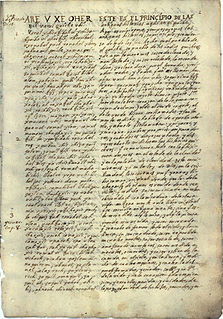
Popol Vuh is a text recounting the mythology and history of the Kʼicheʼ people, one of the Maya peoples, who inhabit the Guatemalan Highlands, Mexican Chiapas, Campeche and Quintana Roo states, and areas of Belize.

The Mayan languages form a language family spoken in Mesoamerica and northern Central America. Mayan languages are spoken by at least 6 million Maya people, primarily in Guatemala, Mexico, Belize and Honduras. In 1996, Guatemala formally recognized 21 Mayan languages by name, and Mexico recognizes eight within its territory.

Piedras Negras is the modern name for a ruined city of the pre-Columbian Maya civilization located on the north bank of the Usumacinta River in the Petén department of northeastern Guatemala. Piedras Negras is one of the most powerful of the Usumacinta ancient Maya urban centers. Occupation at Piedras Negras is known from the Late Preclassic period onward, based on dates retrieved from epigraphic information found on multiple stelae and altars at the site. Piedras Negras is an archaeological site known for its large sculptural output when compared to other ancient Maya sites. The wealth of sculpture, in conjunction with the precise chronological information associated with the lives of elites of Piedras Negras, has allowed archaeologists to reconstruct the political history of the Piedras Negras polity and its geopolitical footprint.
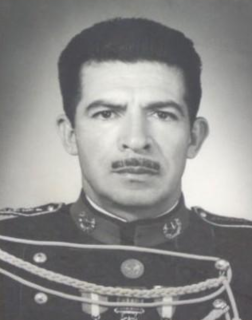
José Efraín Ríos Montt was a Guatemalan general, politician, and war criminal who served as President of Guatemala. Born in Huehuetenango, he was a dictator who took power as a result of a coup d'état on March 23, 1982. He was overthrown by his defense minister, Óscar Humberto Mejía Victores, in another coup d'état on August 8, 1983. In the 2003 presidential elections, Ríos Montt unsuccessfully ran as the candidate of the Guatemalan Republican Front (FRG). In 2007 he returned to public office as a member of Congress, thereby gaining prosecutorial immunity. He was protected from a pair of long-running lawsuits alleging war crimes against him and a number of his former ministers and counselors during their term in the presidential palace in 1982–83. His immunity ended on January 14, 2012, with the end of his term in legislative office. On January 26, 2012, he appeared in court in Guatemala and was formally indicted for genocide and crimes against humanity.
Kʼicheʼ are indigenous peoples of the Americas and are one of the Maya peoples. The Kʼicheʼ language is a Mesoamerican language in the Mayan language family. The highland Kʼicheʼ states in the pre-Columbian era are associated with the ancient Maya civilization, and reached the peak of their power and influence during the Mayan Postclassic period.

The Maya peoples are an ethnolinguistic group of indigenous peoples of Mesoamerica. The ancient Maya civilization was formed by members of this group, and today's Maya are generally descended from people who lived within that historical civilization. Today they inhabit southern Mexico, Guatemala, Belize, El Salvador and Honduras. "Maya" is a modern collective term for the peoples of the region, however, the term was not historically used by the indigenous populations themselves. There was no common sense of identity or political unity among the distinct populations, societies and ethnic groups because they each had their own particular traditions, cultures and historical identity.

The Usumacinta River is a river in southeastern Mexico and northwestern Guatemala. It is formed by the junction of the Pasión River, which arises in the Sierra de Santa Cruz and the Salinas River, also known as the Chixoy, or the Negro, which descends from the Sierra Madre de Guatemala. It defines part of the border between Guatemala and the Mexican state of Chiapas, then continues its northwesterly course, meandering through the Mexican state of Tabasco to the Gulf of Mexico.

Maya script, also known as Maya glyphs, was the writing system of the Maya civilization of Mesoamerica and is the only Mesoamerican writing system that has been substantially deciphered. The earliest inscriptions found which are identifiably Maya date to the 3rd century BCE in San Bartolo, Guatemala. Maya writing was in continuous use throughout Mesoamerica until the Spanish conquest of the Maya in the 16th and 17th centuries.
The traditional Maya religion of the extant Maya peoples of Guatemala, Belize, western Honduras, and the Tabasco, Chiapas, and Yucatán states of Mexico is part of the wider frame of Mesoamerican religion. As is the case with many other contemporary Mesoamerican religions, it results from centuries of symbiosis with Roman Catholicism. When its pre-Spanish antecedents are taken into account, however, traditional Maya religion has already existed for more than two millennia as a recognizably distinct phenomenon. Before the advent of Christianity, it was spread over many indigenous kingdoms, all after their own local traditions. Today, it coexists and interacts with pan-Mayan syncretism, the 're-invention of tradition' by the Pan-Maya movement, and Christianity in its various denominations. It also includes some ties to polytheist religions.

The Ixil Community is a name given to three neighbouring towns in the Quiché department in the western highlands of Guatemala. These towns are Santa Maria Nebaj, San Juan Cotzal, and San Gaspar Chajul. The area's population is predominantly of Ixil descent. When viewed on a map, the three Ixil towns appear to form a triangle, because of this, the Guatemalan military used the term Ixil Triangle when planning its campaigns in this region. Although the term "Ixil Triangle" has been used in some popular handbooks., most people in the region, as well as scholars and indigenous rights activists, avoid using this term as it reproduces the military "gaze", and instead prefer "Ixil region" or "Ixil community."

The traditions of indigenous Mesoamerican literature extend back to the oldest-attested forms of early writing in the Mesoamerican region, which date from around the mid-1st millennium BCE. Many of the pre-Columbian cultures of Mesoamerica are known to have been literate societies, who produced a number of Mesoamerican writing systems of varying degrees of complexity and completeness. Mesoamerican writing systems arose independently from other writing systems in the world, and their development represents one of the very few such origins in the history of writing. The conquistadors brought their distinctive cultural creations, in the form of books, from Europe to the New World which further influenced native literature.

Ancient Mayan art is about the material arts of the Mayan civilization, an eastern and south-eastern Mesoamerican culture shared by a great number of kingdoms in present-day southern Mexico, Guatemala, Belize and western Honduras. Many regional artistic traditions existed side by side, usually coinciding with the changing boundaries of Maya polities. This civilization took shape in the course of the later Preclassic Period, when the first cities and monumental architecture started to develop and the hieroglyphic script came into being. Its greatest artistic flowering occurred during the seven centuries of the Classic Period.

Floyd Glenn Lounsbury was an American linguist, anthropologist and Mayanist scholar and epigrapher, best known for his work on linguistic and cultural systems of a variety of North and South American languages. Equally important were his contributions to understanding the hieroglyphs, culture and history of the Maya civilization of pre-Columbian Mesoamerica.
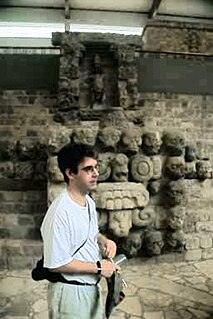
David S. Stuart is an archaeologist and epigrapher specializing in the study of ancient Mesoamerica, the area now called Mexico and Central America. His work has studied all aspects of the ancient Maya civilization. He is widely recognized for his breakthroughs in deciphering Maya hieroglyphs and interpreting Maya art and iconography, starting at an early age. He is the youngest person ever to receive a MacArthur Fellowship, at age 18. He currently teaches at the University of Texas at Austin and his current research includes study of Maya, Aztec and ancient Mesoamerican images and texts.

Maya cave sites are caves used by and associated with the Maya civilization of pre-Columbian Mesoamerica. Certain beliefs and observances connected with cave sites are also maintained among some contemporary Maya communities. These cave sites are understood to have served religious purposes rather than utilitarian ones. Accordingly, archaeological artifacts found within caves can inform interpretations of religious ritual and cave studies combined with epigraphic, iconographic, and ethnographic studies can further inform Maya religion and society.

Kʼinich Yoʼnal Ahk I, also known as Ruler 1, was an ajaw of Piedras Negras, an ancient Maya settlement in Guatemala. He ruled during the Late Classic Period, from 603–639 AD. It has been proposed that he began a new dynasty at Piedras Negras, following years of ineffective kings. As to how Kʼinich Yoʼnal Ahk I came to power, a consensus has not yet been reached, although it is known that he waged several successful wars against Palenque and Sak Tzʼiʼ. He was succeeded by his son, Itzam Kʼan Ahk I, in 639 AD and left behind several monuments, including stelae at Piedras Negras and a large mortuary temple now known as Pyramid R-5.
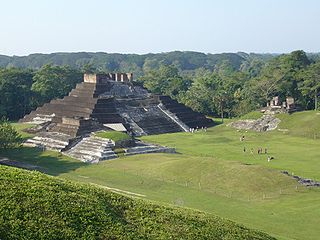
Comalcalco is an ancient Mayan archaeological site in the State of Tabasco, Mexico, adjacent to the modern city of Comalcalco and near the southern coast of the Gulf of Mexico. It is the only major Maya city built with bricks rather than limestone masonry and was the westernmost city of the Mayan civilisation. Covering an area of 7 km2 (2.7 sq mi), Comalcalco was founded in the Late Classic period and may have been a satellite or colony of Palenque based on architectural similarities between the two. The city was a center of the Chontal Maya people.
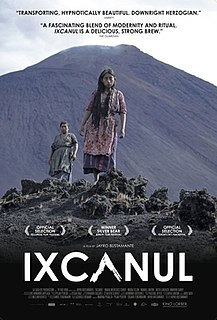
Ixcanul is a 2015 Guatemalan drama film, a debut written and directed by Jayro Bustamante. It was screened in the main competition section of the 65th Berlin International Film Festival where it won the Alfred Bauer Prize. The film was selected as the Guatemalan entry for the Best Foreign Language Film at the 88th Academy Awards but was not nominated. It is the first film produced in the Kaqchikel language of the Mayan family.
References
- 1 2 3 "Obituary: Victor Perera". The Telegraph. 25 August 2003. Retrieved 15 September 2016.
- ↑ "Victor Perera, writer and Sephardic authority, 69, dies". jweekly.
- 1 2 Lavietes, Stuart (June 23, 2003). "Obituary: Victor Perera". New York Times. Retrieved 15 September 2016.
- 1 2 Rourke, Mary (19 June 2003). "Victor Perera, 69". Los Angeles Times. Retrieved 15 September 2016.
- ↑ "Rites". Eland Books. Retrieved 15 September 2016.
- ↑ Herron Zamora, Jim. "Victor Perera -- Chronicler of the Abused, Oppressed". sfgate. Retrieved 15 September 2016.